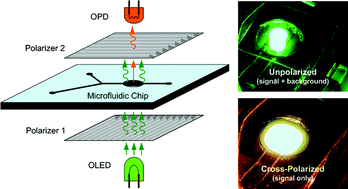We report a high-sensitivity, disposable lab-on-a-chip with a thin-film organic light-emitting diode (OLED) excitation source and an organic photodiode (OPD) detector for on-chip fluorescence analysis. A NPB/Alq3 thin-film green OLED with an active area of 0.1 cm2 was used as the excitation source, while a CuPC/C60 thin-film OPD with 0.6 cm2 active area was used as a photodetector. A novel cost-effective, cross-polarization scheme was used to filter out excitation light from a fluorescent dye emission spectrum. The excitation light from the OLED was linearly polarized and used to illuminate a microfluidic device containing a 1 μL volume of dye dissolved in ethanol. The detector was shielded by a second polarizer, oriented orthogonally to the excitation light, thus reducing the photocurrent due to excitation light leakage on the detector by approximately 25 dB. The fluorescence emission light, which is randomly polarized, is only attenuated by ∼3 dB. Fluorescence signals from Rhodamine 6G (peak emission wavelength of 570 nm) and fluorescein (peak emission wavelength of 494 nm) dyes were measured in a dilution series in the microfluidic device with emission signals detected by the OPD. A limit-of-detection of 100 nM was demonstrated for Rhodamine 6G, and 10 μM for fluorescein. This suggests that an integrated microfluidic device, with an organic photodiode and LED excitation source and integrated polarizers, can be fabricated to realize a compact and economical lab-on-a-chip for point-of-care fluorescence assays.

You have access to this article
 Please wait while we load your content...
Something went wrong. Try again?
Please wait while we load your content...
Something went wrong. Try again?


 Please wait while we load your content...
Please wait while we load your content...